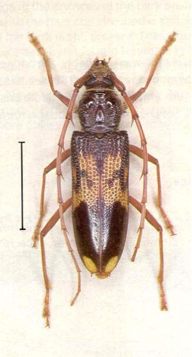PESTS AND DISEASES OF FORESTRY IN NEW ZEALAND
Introduced longhorn beetle (Phoracantha semipunctata) in New Zealand
Scion is the leading provider of forest-related knowledge in New Zealand
Formerly known as the Forest Research Institute, Scion has been a leader in research relating to forest health for over 50 years. The Rotorua-based Crown Research Institute continues to provide science that will protect all forests from damage caused by insect pests, pathogens and weeds. The information presented below arises from these research activities.
Forest and Timber Insects in New Zealand No. 4.
Revised 2009
Based on J. Bain (1976)
Insect: Phoracantha semipunctata (F.) (Coleoptera: Cerambycidae)

Fig. 1 - Phoracantha semipunctata adult.
The line shows natural length
Type of injury
Phoracantha semipunctata larvae bore under the bark and in the sap-wood of dead or dying trees and in logs.
Hosts
Many species of Eucalyptus , especially E. globulus and E. viminalis, are hosts to this insect.
Distribution
This Australian insect was probably introduced into New Zealand through trade in railway sleepers in the 1870s. It has also been introduced into South Africa, South America, the Middle East, Europe, North Africa and North America. It is now very widespread. The exact distribution in New Zealand is not known but it is probably found wherever eucalypts are grown.
Economic importance
Phoracantha semipunctata is encountered only infrequently and at present is of no economic significance. However, eucalypts are not being utilised to any great extent and logs are not available for the insect to attack. It has been recorded as attacking and girdling living trees in Israel (Bytinski-Salz and Neumark, 1953).
Description, life history, and habits
As with many longhorn beetles, the size of the adults can vary greatly. They can be from 16 to 30 mm in length. They are basically reddish-brown, except for the elytra (wing cases) which have a straw-coloured band across the middle and a spot at the rear end (Fig. 1). Segments 3-7 of the antennae have a distinct spine on the inner side. In the female the antennae are as long as the body but those of the male are considerably longer. The front halves of the elytra have coarse punctures but the rear halves are smooth. Each elytron has two spines at the rear. In mature larvae, which can attain a length of slightly more than 30 mm, a single ocellus (simple eye) can be seen on either side of the gouge-like jaws. Outside the ocellus there is a well-defined vertical groove. These features can be seen with a x10 hand-lens when the head is viewed from the front.
Adult beetles are usually found during the summer months, and the females lay their eggs in the crevices of the bark on dead or dying trees and logs. Only material with the bark still attached is attacked, but dry material is not attacked even if the bark is still present. The eggs are usually deposited in batches of various sizes. Bytinski and Neumark (1953) recorded batches of 10-100 (average 43.5). The eggs hatch in 10-14 days. The larvae feed for about four to six months under the bark making wide galleries that are tightly packed with frass. These galleries, which may extend approximately 1-2 metres, often run parallel to each other and rarely cross (Fig. 2).
When mature, the larvae bore obliquely into the wood to pupate. The pupal period lasts about ten days.

Fig. 2 - Larval workings of P. semipunctata under the bark of Eucalyptus.
The life cycle is probably annual and FRI records show that adults can be found from October to March, but in Australia adults have been collected in all months of the year (Duffy, 1963).
Control
No control measures are taken at present because none are necessary but, if the insect does become a problem, prompt extraction of logs from the forest or the stripping of bark from the logs will reduce infestations to a minimum.
Biological control of P. semipunctata in California using the host-specific egg parasitoid, Avetianella longoi Siscaro, has been highly successful with parasitism rates exceeding 90%.
Bibliography
Duffy, E.A.J. 1963: A monograph of the immature stages of Australasian timber beetles
(Cerambycidae). British Museum, London. 235 p.
Bain, J. 1976: Phoracantha semipunctata (Fabricius) (Coleoptera: Cerambycidae). New Zealand
Forest Service, Forest and Timber Insects in New Zealand No. 4
Bytinski-Saiz, H. and Neumark, S. 1953: The eucalyptus borer (Phoracantha semipunctata F.) in
Israel. Transactions of the IXth International Congress of Entomology, Amsterdam,
August 17-24, 1951, 1: 696-699.
Hanks, L.M.; Millar, J.G.; Paine, T.D.; Wang, Q. and Paine, E.O. 2001: Patterns of host utilization by two parasitoids (Hymenoptera: Braconidae) of the eucalyptus longhorned borer (Coleoptera: Cerambycidae). Biological Control 21: 152-159.
This information is intended for general interest only. It is not intended to be a substitute for specific specialist advice on any matter and should not be relied on for that purpose. Scion will not be liable for any direct, indirect, incidental, special, consequential or exemplary damages, loss of profits, or any other intangible losses that result from using the information provided on this site.
(Scion is the trading name of the New Zealand Forest Research Institute Limited.)

 Farm Forestry New Zealand
Farm Forestry New Zealand

